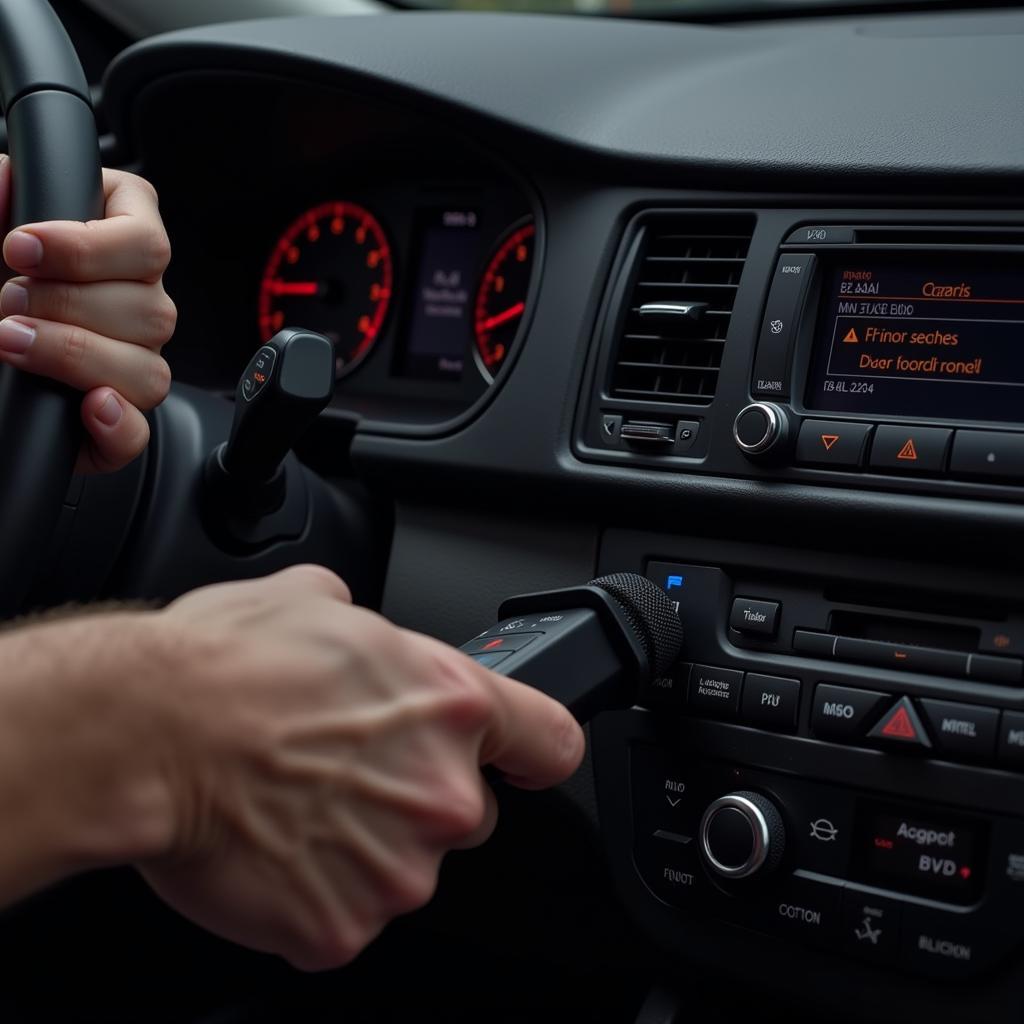Have you ever found yourself driving at night and noticed your headlights aren’t illuminating the road properly? Or maybe you’ve installed new headlights and need to adjust them for optimal visibility? If so, you’re not alone. Many car owners struggle with headlight alignment, but with the right tools and knowledge, it’s a simple fix.
In this guide, we’ll explore how to utilize VCDS 55 coding to adjust your headlights for optimal performance. VCDS, short for “Vehicle Diagnostic System,” is a powerful diagnostic and coding tool for Volkswagen, Audi, Seat, and Skoda vehicles. It allows you to access and modify various vehicle settings, including headlight adjustment.
What is VCDS 55 Coding?
VCDS 55 coding refers to using the VCDS tool to access and modify the control module responsible for managing your headlights. This module stores information about various headlight settings, including their alignment, height, and even the type of bulbs installed. By accessing these settings through VCDS, you can make adjustments to optimize your headlight performance.
Why Adjust Your Headlights?
Proper headlight alignment is crucial for safe driving, especially at night. Here are some reasons why you should consider adjusting your headlights:
- Improved visibility: Correctly aligned headlights will project a focused beam of light onto the road ahead, enhancing your ability to see obstacles and road markings.
- Reduced glare: Misaligned headlights can cause glare for oncoming drivers, making it difficult for them to see the road ahead.
- Preventing accidents: Poor headlight alignment can lead to reduced visibility and an increased risk of accidents.
- Compliance with regulations: Many countries have regulations regarding headlight alignment, ensuring all vehicles meet minimum safety standards.
Understanding Headlight Adjustment
Headlights are typically adjusted using two main parameters:
- Vertical adjustment: Controls the height of the light beam.
- Horizontal adjustment: Controls the left-to-right positioning of the beam.
How to Adjust Headlights Using VCDS 55 Coding
Here’s a step-by-step guide on using VCDS 55 to adjust your headlights:
- Connect VCDS to your vehicle: Connect the VCDS cable to your vehicle’s OBD-II port and ensure the ignition is turned on.
- Select the correct control module: Navigate through the VCDS interface to select the “Headlights” or “Lighting” control module.
- Locate the adjustment parameters: Once you’ve selected the correct module, you’ll need to identify the specific parameters responsible for adjusting your headlights. These may be labeled differently depending on your vehicle’s make and model.
- Make adjustments: Adjust the vertical and horizontal parameters according to the manufacturer’s specifications or using a headlight alignment tool for accurate adjustment.
- Save changes: Once you’ve made the desired adjustments, save the changes using VCDS.
- Test and re-adjust: After saving, test your headlights on a wall or a flat surface at a specified distance. If needed, make further fine-tuning adjustments.
VCDS 55 Coding: Tips and Precautions
- Consult your owner’s manual: Always refer to your vehicle’s owner’s manual for specific instructions and recommended headlight adjustment settings.
- Use caution: Modifying vehicle settings through VCDS can be complex, so be cautious and proceed with care.
- Avoid exceeding factory limits: Don’t attempt to adjust your headlights beyond the manufacturer’s specifications, as this can affect their performance and safety.
- Consider professional help: If you’re unsure about adjusting your headlights or lack experience using VCDS, consider seeking professional help from a qualified mechanic.
What if My Headlights Can’t Be Adjusted Through VCDS?
While VCDS 55 is a powerful tool for adjusting headlights, not all vehicles have the necessary functionality enabled. Some vehicles might not offer headlight adjustments via VCDS, or the adjustments may be limited. In these cases, you may need to explore alternative methods, such as:
- Manual adjustment: Some vehicles have manual adjustments located on the back of the headlight unit.
- Professional alignment: A mechanic can use specialized equipment to align your headlights accurately.
FAQ
Q: Is it safe to use VCDS 55 to adjust my headlights?
A: Using VCDS 55 to adjust your headlights is generally safe if you follow the instructions carefully and don’t exceed the factory specifications. However, it’s always a good idea to consult your owner’s manual for specific guidance and proceed with caution.
Q: How often should I adjust my headlights?
A: It’s a good idea to check your headlights for alignment periodically, especially after hitting a curb or encountering any impact that might affect their positioning.
Q: Can VCDS 55 be used to adjust fog lights?
A: The functionality for adjusting fog lights through VCDS depends on your vehicle’s make and model. Some models might have specific settings for fog lights, while others might not.
Q: I don’t have a VCDS cable. What can I do?
A: You can purchase a VCDS cable online from various retailers or through a local automotive parts store.
Q: Can I adjust my headlights without using VCDS?
A: While you can adjust some headlights manually, it’s often more challenging and less precise than using VCDS. For accurate and safe adjustments, professional headlight alignment is recommended.
Conclusion
Adjusting your headlights using VCDS 55 coding is a relatively simple process that can significantly improve your visibility and safety while driving at night. However, it’s essential to approach this task with caution and always refer to your vehicle’s owner’s manual for specific instructions. If you’re not comfortable making adjustments yourself, consider seeking professional assistance from a qualified mechanic. By optimizing your headlights, you’ll ensure a more enjoyable and safe driving experience.

